“Nailed It!”
It’s a popular expression describing the feeling when you hit your target or your stride.
It’s also the name of a popular Netflix® TV show.
On Nailed It! amateur bakers come together to re-create complex, detailed cakes and cookies with limited help. When the contestants don’t rise to the occasion, the results can be hilarious as shown in the example below.

In this example, the contestants had to make a dinosaur cake that resembles the professionally baked one on the left. Clearly, this contestant did not nail it. This sheds a humorous light on the importance of recipes.
What went wrong?
We’ve all heard people say, “The process is broken.” But what does that really mean? How do you know when a process is broken?
Let’s explore this and make lemonade. Well, not exactly. Let’s pretend you are in the lemonade-making business. We’ll go behind the curtain of your operation so you’ll learn how to identify, document, and improve “broken” processes in 5 steps.
But first, let’s start with defining a process.
What is a Business Process?
A business process is “The sequential order of steps necessary to achieve a desired result.” It represents the conversion of inputs into outputs.

A simpler definition that I often tell people is that a process is a business recipe.
Well-written recipes ensure consistent results. Producing lemonade according to your specifications requires inputs (lemons, water, some type of sweetener) and a detailed recipe (process) to create lemonade (output). Like recipes, processes that omit certain steps, tools, and people can yield disastrous results.
Step #1: Identify Processes Per Department
Remember the exercise from the last post where you had to identify tasks and write them onto small notecards and later group them into departments?
Now I want you to look at the tasks within each department and group those that are similar in nature.
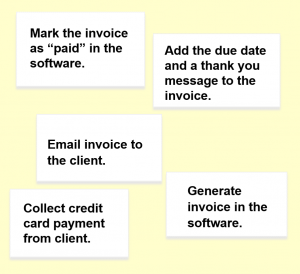
Assign process names to these sub-groups. In the example to the left, these tasks make up a “Billing” process. You may also call it an “Invoicing” or “Accounts Receivable” process.
Step #2: Document the Process
Take each sub-group of tasks within a department and place them in sequential order.

Now it’s time to figure out the best way to document the actual process. There are many ways including a standard operating procedure, checklists, and video. In this example, we’re going to represent the process as a flowchart. You can use tools like MS PowerPoint and MS Visio to achieve this.
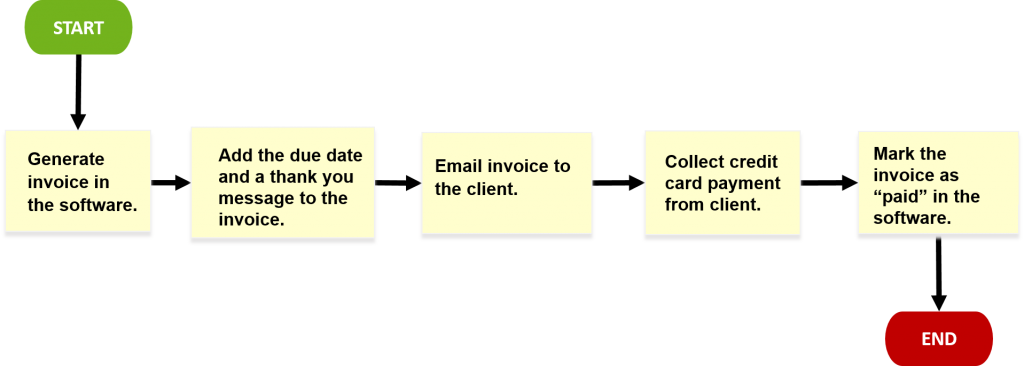
Step #3: Fill Gaps & Poke Holes
When you know a process is broken, flowcharts (when mapped correctly) make it easy to visually detect when and where bottlenecks occur. You will notice steps missing. It is your job to fill in those gaps and poke holes in the process by challenging yourself to think of what can go wrong throughout the process.
One way to do this is to add conditions in the form of questions or if/then statements. After all, it can be rare to have a process 100% incapable of hiccups.
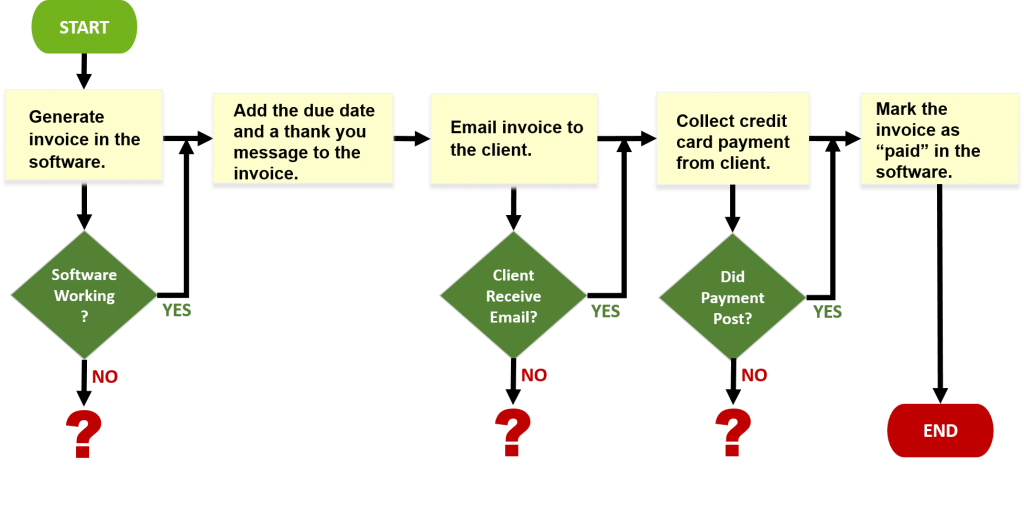
In the above flowchart, bottlenecks can occur with the invoicing software, email, and payment. You have to figure out what mitigation plan you will have in place in the event the process gets stuck at one of these bottlenecks.
Step #4: Test
Mitigation plans can include troubleshooting processes. That means, if, for example, a customer’s payment did not post, rather than playing cat-and-mouse with your customer, you can initiate a Collections process to ensure full payment. This is still a bottleneck, but at least there is a documented, standard way of handling non- or late payment.
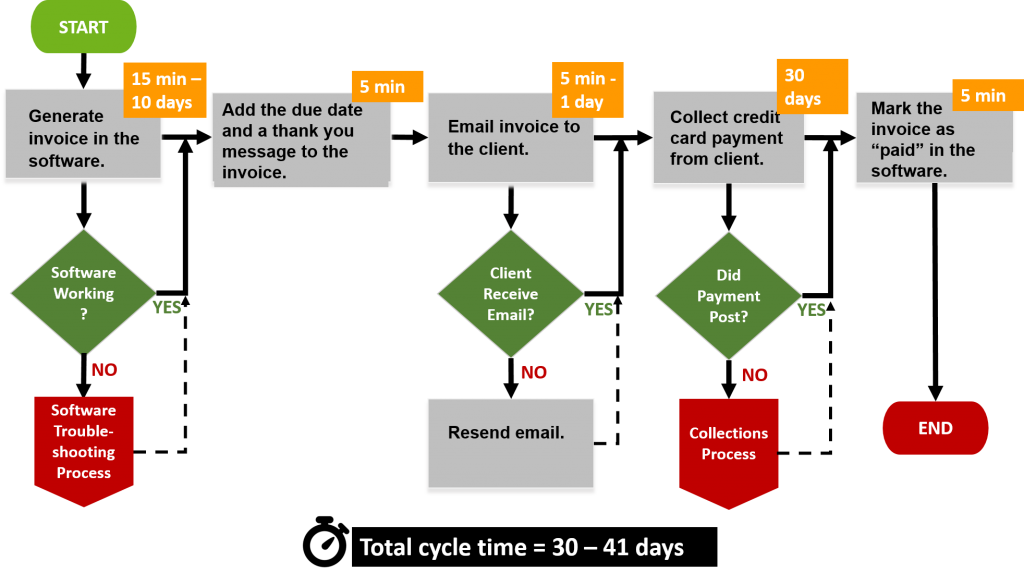
When you’ve documented the main and troubleshooting processes, give it to a couple of people on your team to test. If they can produce the desired result, then you have a well-documented process! If not, then fill in more gaps and test again.
Testing also gives you an opportunity to measure the average time it takes to complete a process. This is known as cycle time. In this example, the Billing process can take anywhere from 30 – 41 days, depending on the availability of the people involved.
Step #5: Monitor & Improve
Once you’ve computed a cycle time, you may want to figure out how to reduce it. It could be that a long cycle time equates to a broken process. This is where automation, outsourcing, and upgrading certain equipment and software can help. As an example, look at how much the cycle time is reduced when process improvements are made.
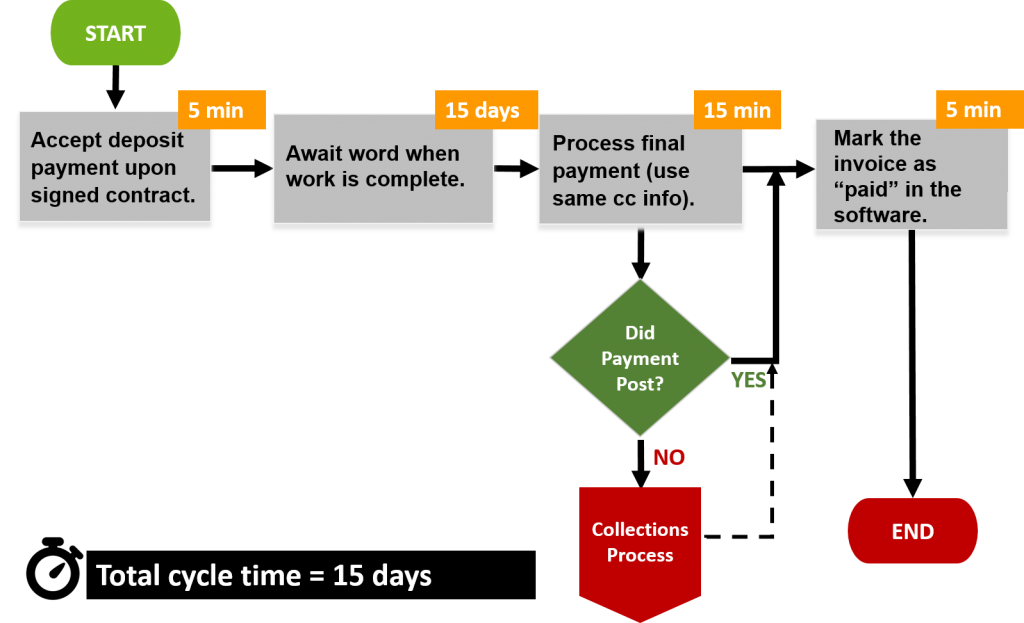
By accepting deposit payments at the start of an order and programming the software to automatically bill once services are rendered, the cycle time is cut by 50%! This improvement also stimulates cash flow – accepting a deposit and final payment ensures a steadier flow of money into your coffers rather than relying on a particular team member to collect one payment once an order is delivered.
Read More…
This is by no means a primer on business processes. Processes can get very complex and there are many factors to take into consideration. If you want to learn more about those factors, then check out my book, Behind the Façade: How to Structure Company Operations for Sustainable Success. It’s available anywhere books are sold. The E-book is available only on Amazon.

Nail It or Fail It?
Back to Nailed It! Hopefully you now see the correlation between processes and recipes.
When you leave out important details or expect your team to perform in unrealistic conditions, it will show in a poor quality product or service.
Contestants on Nailed It! are given recipes with vague or missing steps and very short time frames. Don’t do this with your business recipes! The onus is on you to write recipes that will enhance your customer’s experience. Like anything, practice makes perfect. You won’t nail your processes down the first time around.
Failure is part of the journey. Giving up is not.

Just as food brings people together, so can your processes serve as the glue to bring your people and tools/technologies together. Before you know it, you will have a collection of business recipes that form your cookbook (or Operations Manual).
Here’s to cooking up success!












